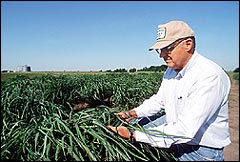Biofuel sounds like a pretty good idea — down with power plants, up with regular plants! — but if the country switches over to corn ethanol we will basically be unable to grow any other crops. A new study has calculated that corn destined for ethanol production would have to take over 80 percent of current farmland in order for the country to meet current biofuel goals. But next generation biofuels can come from many other plants besides corn. And for the first time, they might be commercially viable.
A California company called Virdia has raised funds to build what will be the first commercial plant to make cellulosic biofuel. Cellulose is in all plants; the Virdia plant will start by processing wood but could one day use switchgrass, which is much more energy-efficient to grow in the first place. Cellulose is energy-rich but harder to break down than the simple sugars in corn. So far no one’s been able to make money doing it.
If cellulosic ethanol can succeed commercially, though, ethanol could come from the corn stalks of the corn that American farmers are already growing to turn into high fructose corn syrup, for instance. It’s not perfect, but if the country’s going to pursue ethanol, this is the best way to do it.



